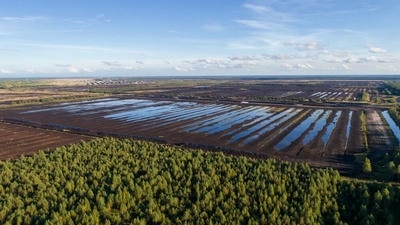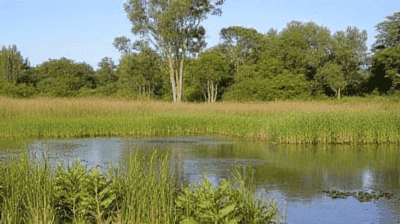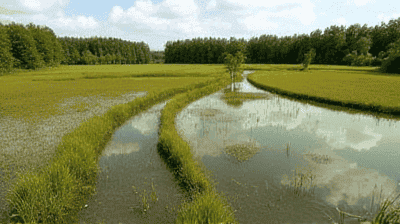
Grasslands are often underappreciated in discussions about critical ecosystems and sustainable farming practices. These expansive landscapes, characterized by vast open spaces dominated by grasses and other herbaceous plants, offer much more than meets the eye. They play a vital role in carbon sequestration, biodiversity support, and agricultural sustainability. When integrated with peatland conservation efforts, grassland farming practices emerge as a powerful tool for mitigating climate change and preserving essential ecosystem functions.
Grasslands are ecosystems where grasses dominate the vegetation. They can be categorized into several types, primarily based on geographical location, climate, and soil conditions:
Temperate Grasslands: Found in regions with moderate rainfall and seasonal temperature variations. Notable examples include the prairies of North America and the steppes of Eurasia.
Tropical Grasslands: Characterized by warmer temperatures and periodic drought. The savannas of Africa and the Brazilian cerrado represent this type.
Floodplain Grasslands: Found along riverbanks and floodplains, supporting rich biodiversity due to the seasonal inundation of waters.
Alpine Grasslands: Located at high altitudes, these grasslands are adapted to cold temperatures and shorter growing seasons.
Grasslands provide numerous ecological services, making them a vital component of global ecosystems:
Carbon Sequestration: Grasslands store significant amounts of carbon in their root systems and soils, which helps mitigate climate change.
Biodiversity Reservoirs: These ecosystems support a wide range of plant and animal species, many of which are uniquely adapted to grassland habitats.
Soil Health: Grassland vegetation helps maintain soil structure and fertility, preventing erosion and promoting nutrient cycling.
Water Regulation: Grasslands play a crucial role in maintaining hydrological cycles, improving water infiltration, and reducing runoff.
Grazing and Agriculture: Grasslands are essential for livestock grazing, providing forage for animals and important livestock products for human consumption.

Peatlands are unique wetland ecosystems characterized by the accumulation of peat, a type of organic matter formed from the partial decomposition of plant material in waterlogged conditions. These ecosystems include bogs, fens, and marshes, and they are often rich in biodiversity.
Peatlands play several critical roles in environmental health and climate stability:
Carbon Storage: Peatlands are some of the most effective carbon sinks on the planet, storing approximately one-third of the world’s soil carbon, despite covering only about 3% of the Earth’s land surface.
Biodiversity Hotspots: Peatlands support a diverse array of flora and fauna, including many specialized plant and animal species.
Water Quality Regulation: Peatlands filter water by trapping sediments and pollutants, contributing to cleaner waterways.
Flood Mitigation: During periods of heavy rainfall or flooding, peatlands can absorb excess water, helping to alleviate the impacts of floods on surrounding areas.
Despite their ecological importance, peatlands are under threat from various human activities:
Agricultural Expansion: Drainage of peatlands for agriculture leads to the loss of peat and carbon release into the atmosphere.
Urban Development: Urban encroachment can result in the destruction of peatlands and their ecosystems.
Climate Change: Changing climate conditions can alter hydrology and vegetation dynamics, impacting peatland health.
Pollution: Agricultural runoff containing fertilizers and pesticides can degrade peatland ecosystems and water quality.
The relationship between grasslands and peatlands is complex and interconnected. Integrating sustainable grassland practices can greatly benefit the conservation of peatlands in several ways:
Surface Water Management: Healthy grassland systems can help manage surface water inputs into peatlands, maintaining the necessary hydrological conditions for peat accumulation.
Reduction of Erosion: Grassland vegetation reduces soil erosion and runoff, which can carry sediments and pollutants into nearby peatlands.
Light Grazing Practices: Sustainable grazing practices in grasslands can promote nutrient cycling and prevent overgrowth of woody species that could alter hydrology in adjacent peatlands.
Numerous ecosystems exemplify the synergy between grasslands and peatlands:
Northern European Peat Bogs: In regions like Scandinavia, traditional grazing practices in adjacent grasslands help to maintain the hydrology and biodiversity of surrounding peat bogs.
North American Prairie Potholes: Grasslands in the Prairie Pothole Region often serve as buffers for wetland habitats, providing a transition that enhances water quality and biodiversity.
Sphagnum-Dominated Systems: In some cases, grasslands rich in sedges and other herbaceous plants can transition into peat-forming ecosystems, demonstrating the ecological continuum between these systems.

Sustainable farming practices in grasslands are essential for preserving ecosystems while meeting agricultural needs. These practices enhance soil health, improve water quality, and protect biodiversity, all while ensuring long-term agricultural viability.
Rotational Grazing: This method involves rotating livestock between pastures, which allows grasslands to recover and promotes healthier soil and plant communities. This practice minimizes overgrazing and enhances root development.
Cover Cropping: Planting cover crops during off-seasons protects soil from erosion, increases organic matter, and enhances soil fertility. Cover crops also manage water runoff and improve nutrient cycling.
Reduced Chemical Inputs: Limiting the use of synthetic fertilizers and pesticides can promote soil health and reduce non-point source pollution that can negatively impact adjacent peatlands.
Integrated Pest Management (IPM): Employing IPM strategies that focus on monitoring and managing pest populations sustainably can reduce reliance on harmful chemicals and promote ecological balance.
Agroforestry: Integrating trees into grassland farming systems can enhance habitat diversity and improve water retention, benefiting both grasslands and surrounding wetlands.
Implementing sustainable practices in grasslands yields several benefits:
Soil Health Improvement: Healthy soils are crucial for agricultural productivity. Sustainable practices help build soil structure, enhance microbial activity, and retain moisture.
Biodiversity Support: Sustainable farming promotes diverse plant and animal communities, leading to increased resilience within both grassland and peatland ecosystems.
Climate Resilience: Improved soil health and enhanced vegetation cover contribute to greater climate resilience, allowing ecosystems to better adapt to changing conditions.
Economic Viability: Sustainable farming practices can enhance long-term profitability for farmers by reducing input costs and improving yield stability.
In the Great Plains region of North America, ranching practices have been adapted to enhance the health of both grasslands and adjacent wetlands. Through rotational grazing systems, ranchers have improved forage quality and reduced soil erosion.
The Fens, a peatland region in Eastern England, have undergone significant restoration efforts involving sustainable grazing on adjacent grasslands. Farmers in the area have adopted practices that promote biodiversity while maintaining productive agricultural land.
In countries like the Netherlands and Belgium, integrated agricultural management practices are being employed across grasslands and peatlands. These strategies include water management to mimic natural hydrological cycles.

Effective policies are essential for promoting sustainable grassland and peatland management:
Agricultural Subsidies: Implementing financial incentives for farmers who adopt sustainable practices can encourage participation in conservation efforts.
Wetland Protection Regulations: Enforcing regulations that protect peatlands from drainage and degradation ensures that adjacent grasslands are managed sustainably.
Integrated Land-Use Planning: Coordinating land use at regional levels can support ecosystem connectivity, enabling better management of both grasslands and peatlands.
Community involvement is crucial for achieving long-term success in grassland and peatland conservation:
Local Workshops: Organizing educational workshops for farmers can help build awareness about the benefits of sustainable practices and the importance of peatland conservation.
Collaboration with NGOs: Partnering with non-profit organizations can foster community-driven conservation initiatives that enhance capacity building and resource sharing.
Citizen Science Projects: Encouraging local communities to participate in monitoring programs can enhance engagement and promote stewardship of both grassland and peatland ecosystems.
While the integration of sustainable grassland practices and peatland preservation is promising, challenges remain:
Climate Variability: Increasingly severe weather events and shifting climate patterns may impact the resilience of both grassland and peatland ecosystems.
Economic Pressures: Farmers may face economic pressures to prioritize short-term gains over long-term sustainability, threatening the adoption of sustainable practices.
Inadequate Policy Support: Inconsistent or weak policy frameworks can hinder the implementation of effective ecosystem management strategies.
Opportunities to expand sustainable management of grasslands and peatlands are abundant:
Advancements in Research: Ongoing scientific research can provide new insights into best practices for managing grasslands and peatlands, ensuring that strategies are grounded in the latest ecological understanding.
Community-Driven Initiatives: Grassroots movements that advocate for sustainable practices can mobilize public support and increase participation in conservation efforts.
International Collaboration: Global partnerships focusing on climate resilience and biodiversity conservation can lead to shared knowledge and resources, ultimately benefiting ecosystems worldwide.
Grasslands play an essential role in preserving peatlands, providing a sustainable farming practice that enhances ecological health while supporting agricultural needs. The connection between these ecosystems offers a valuable opportunity for mitigating climate change, improving biodiversity, and ensuring long-term food security.
Through the implementation of sustainable practices in grassland management, we can preserve peatlands and their vital ecosystem services for future generations. By recognizing the interdependence of these systems, fostering community involvement, and advocating for robust policy frameworks, we can work toward a more sustainable and resilient future.
Investing in the health of both grasslands and peatlands is a commitment to environmental stewardship, economic vitality, and the well-being of our planet. Together, we have the opportunity to promote a sustainable relationship between farming and conservation, ensuring that nature continues to thrive alongside human development.